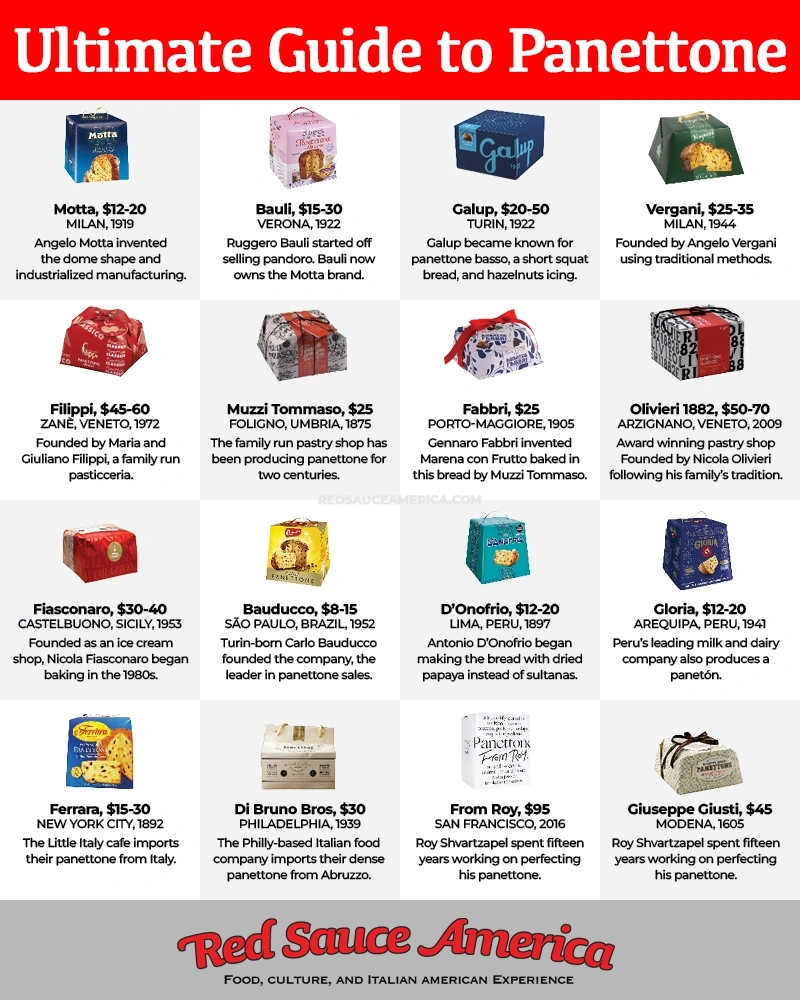The Red Sauce America Guide to Christmas Panettone
By Ian MacAllen on Friday, December 1st, 2023 at 10:33 pm | 3,735 views
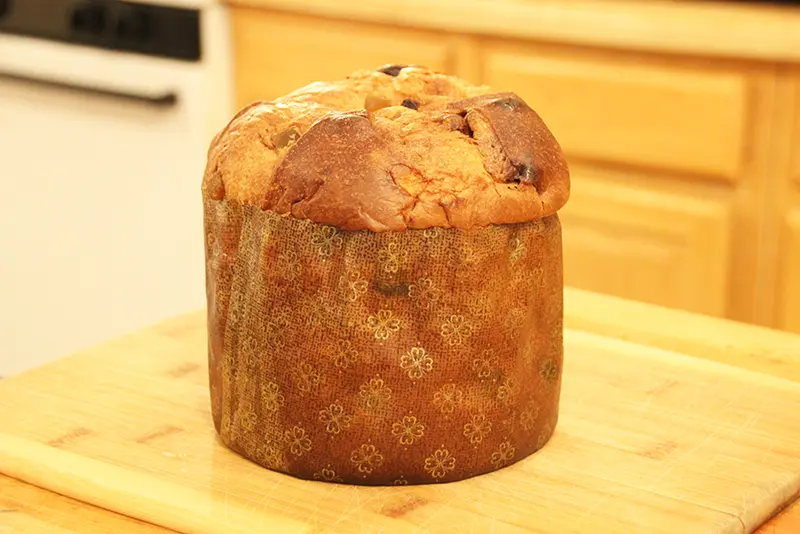
Nothing is quite like cutting open a panettone on Christmas morning. It’s a tradition that has been in my family since before I even liked eating bread filled with candied fruit. While Panettone has become an important Italian Christmas tradition, the modern recipe synonymous with the holiday only evolved in the mid-twentieth century.
Today, the bread is made with enriched dough, a brioche-type bread that bakes up light and fluffy, a rich golden yellow, and filled with candied fruit. The tall breads have a dome, intended to look like the cupola of a cathedral. Shorter versions known as panettone basso have a similar shape, but not quite the same rise. The classic Milanese panettone includes a light citrus flavor in the dough, and it’s topped with powdered sugar or icing. Some variations now are filled with cream flavored with almonds, coffee, chocolate, or pistachio.
The modern recipe is a complicated one requiring several days to prepare, including a period where the dough is let to ferment. Most panettone is made by professionals, and even industrial made panettone can take anywhere from 36 to 60 hours from start to finish. The process produces the delicate texture of the bread with large, irregular air pockets. After baking, the breads are hung upside down to cool, helping to keep the fluffy interiors.
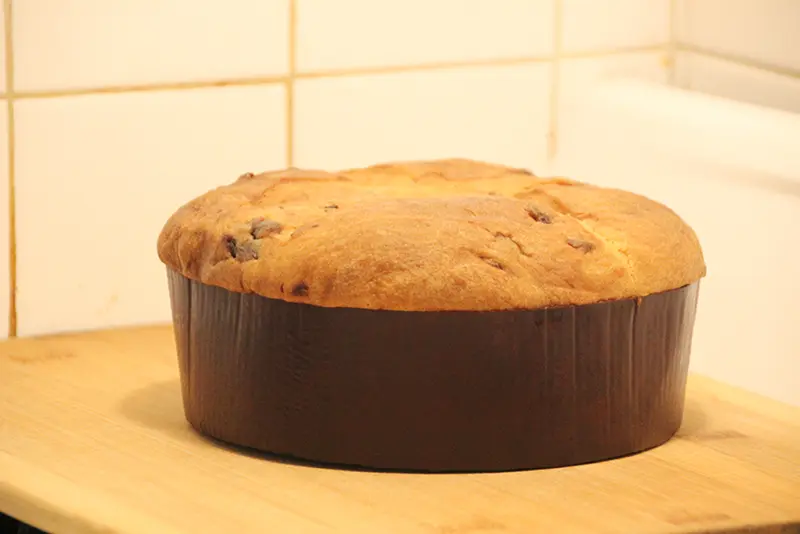
ANCIENT PANETTONE
The earliest predecessor to panettone dates back to the ancient Romans who baked enriched breads filled with dried fruit and sweetened with honey. Refined sugar wouldn’t become a major part of the Italian diet until the Renaissance, so honey was the primary sweetener.
The Roman-era cookbook, Apicius: De re Coquinaria, compiled around the 5th Century includes several related cake recipes. The honey cakes were often baked as tribute to the gods. Roman cakes similar to the modern Pangiallo Romano, a denser Roman fruitcake also common at Christmas, was served at the winter solstice. Like panettone, it is known for its bright yellow dough.
MEDIEVAL PANETTONE
The evolution of Roman-era fruitcakes into panettone took a big step forward in the 1500s. The 1570 cookbook by Bartolomeo Scappi, Opera dell’arte del cucinare, contains a recipe for a similar fruit-filled bread.
What differentiated this Renaissance-era bread was using an all-wheat flour. Other flours made from rye, oat, and spelt were cheaper and more common, but the resulting breads were dark and tough. As early as 1395, the Milanese would celebrate Christmas with loaves of white bread. A decree in that year ordered bakeries to produce pan de’ sciori or pan del ton. But by the Renaissance, wheat yields increased through new farming techniques and expansion of arable land, and refined sugar also became more readily available. Both developments made panettone even more luxurious and closer to the modern version of the bread.
Panettone grew into a Christmastime staple in Milan and surrounding areas during this period. While it’s likely the tradition evolved from Roman-era fruitcakes served to the gods during the winter solstice, there are a variety of legends explaining how panettone might have become a Christas treat.
The most common of these links the bread to Ludovico Sforza, the Duke of Milan, who ruled the Dutchy from 1494 to 1499 until he was forced to flee the city and ultimately imprisoned. This first legend begins on Christmas Eve when the Duke’s baker burned the bread intended for Christmas dinner. Supposedly, a kitchen assistant by the name of Toni saved the day by enriching an ordinary sourdough with eggs and adding raisins. The bread, served to the Duke on Christmas morning, proved delicious enough to become a tradition.
Another legend credits a nun, Sister Ughetta, for making a golden-colored cake filled with raisins as a way to celebrate Christmas. The impoverished nuns of the order had little to look forward to. Sister Ughetta brought them cheer on the holiday by baking the special bread. The term ughett translates to “raisin” in the dialect of Milan and may explain the origin of this myth.
In another version of this story, Ughetto is instead a nobleman, Ughetto della Atellani. Ughetto meets Adalgisa, the daughter of a local bake and falls in love with her. However, Ughetto’s wealthy family disapproves of Adalgisa because her family is poor. Ughetto’s love cannot be contained, and he begins working with the baker, developing the panettone recipe and helping the baker grow wealthy. The Italian American children’s book author Tomie DePaola plays with this myth in his 1989 book, Tony’s Bread.
While DePaola alludes to the term panettone as originating with a baker named Tony, it’s more likely the term evolved from other sources. Panettone may have evolved from the word “panetto,” meaning small bread or small loaf. Alternatively, it may have evolved from the phrase “pane di tono,” meaning a fancy bread. As early as 1606, the phrase “Panaton de Danedaa” was used in Milanese dictionary to describe a Christmas bread.
19TH CENTURY PANETTONE
The nineteenth century saw additional changes. By then, a dictionary published by Francesco Cherubini published in 1839 referred to a bread simply as Panatton or Panaton. The enriched bread included raisins. But in 1854, in a recipe collection by Giovanni Felice Luraschi, “Il nuovo cuoco Milanese economico”, the recipe includes yeast for the first time.
By the end of the 19th century, Pellegrino Artusi’s La Scienza in Cucina e l’Arte di Mangiar Bene, Science in the Kitchen and the Art of Eating Well included a recipe for Panettone Marietta. The panettone was named in honor of Marietta Sabatini, his housekeeper and personal assistant.
Marietta’s bread lacks yeast, meaning it doesn’t have the same rise as modern panettone. Instead, the Artusi bread relied on baking soda and baking powder. However, the 1891 recipe collection does represent a cross section of the foods in the newly united Italian nation showing how this tradition began spreading beyond Milan and across Italy.
MODERN PANETTONE
The 20th century saw the birth of the modern panettone. At the turn of the century Pastry chef Giuseppe Ciocca wrote in his 1907 book The Modern Pastry Chef and Confectioner about the export of panettone bread across the globe, particularly to the Americas. Ciocca celebrated the use of mechanical baking tools and the industrial production of the luxurious bread, with kneading by mixer half the time it took to do by hand.
Panettone is most often purchased by Italians rather than baked at home, in part because of the complicated production. The shift likely began with Ciocca’s push toward modernization.
Despite the industrialization of the bread production, Ciocca’s panettone still lacked one key element seen in modern breads: the dome shape.
Motta
The tall dome of modern panettone is credited to Angelo Motta, a baker and ultimately an industrialist. Motta, a pastry chef born in a municipality in Milan, learned to bake before World War I. However, he saw himself pressed into military service, delaying the opening of his own bakery.
Motta finally opened his first shop in 1919. His first product was a Christmas Panettone, by then a beloved holiday treat in Milan. Through his experiments and investments, he eventually developed the unique dome shape for the bread designed to look like a church cupola.
More importantly, he refined the industrial process for baking the bread. Panettone still requires several days to manufacture, but mechanical tools like mixers helped reduce the physical labor.
Alemagna
About the same time that Motta was baking up his tall panettone, Gioacchino Alemagna opened his first confectionery shop in Milan. By 1925, Alemagna had a cafe selling pastries. He turned that success into an even larger shop overlooking the main Cathedral, the Piazza del Duomo, opening the flagship cafe and pastry shop in 1933.
Alemagna also industrialized panettone production. He began opening factories before the Second World War producing a number of sweets and baked goods.
Alemagna and Motta both developed the luxury Christmas bread into a mass-produced commodity. By the 1970s, the post-war Italian economic boom over, the companies struggled under large debt. Eventually they merged in 1976, passing through a variety of holding companies until Nestlé acquired them in 1993.
Finally they returned to Italian control in 2009 when the company Bauli acquired them.
SOUTH AMERICAN PANETTONE
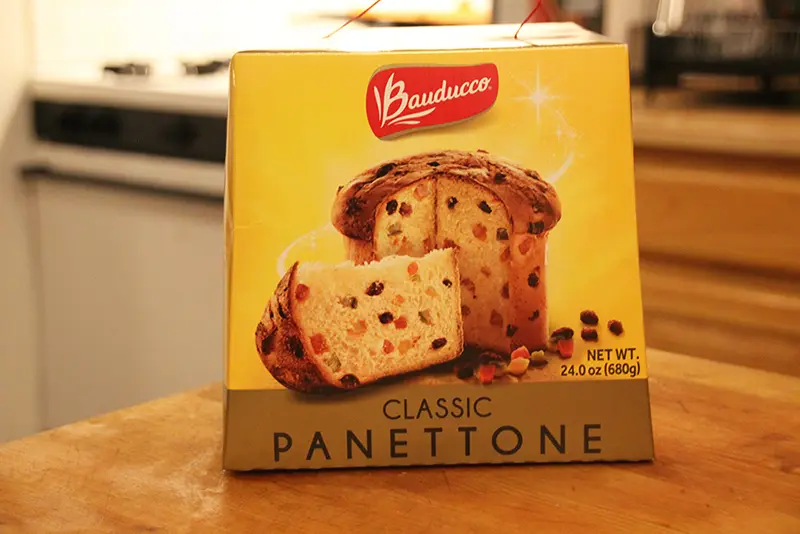
Bauducco
The largest manufacturer of Panettone today is the Brazilian company Bauducco. The low-cost panettone comes in bright yellow boxes and is widely available not just in South America but the United States as well. It’s found in supermarkets rather than specialty shops.
Carlo Bauducco, was born in Turin, Italy in 1906. After World War II, Bauducco began exporting bread-making equipment to Brazil. He sent forty machines to South America, but never received payment, and in 1948 he headed off to Brazil to find out what happened to the equipment or the money.
The profits had ended up invested in coffee plantations. The real money, Bauducco realized, would not be in baker equipment, but instead in selling panettone to the many Italians living in São Paulo. He returned in 1950 bringing a sourdough starter with him. Due to local laws, he set up a partnership with local Brazilians and set about baking breads.
By 1952, the law requiring local partnerships ended and Bauducco set up his confectionary shop, Doceria Bauducco. The firm industrialized in the 1960s, and started exporting out of Brazil in the 1970s. The company helped turn Panettone into a staple, and Bauducco brand panettone is available just about any time of the year. Today there is even a factory in Miami producing the bread for the American market.
D’Onofrio
Another South American panettone manufacturer, D’Onofrio, was originally founded by Italian-born Pietro D’Onofrio.
In Peru, the bread is known as “panetón,” where it is consumed at Christmas and during the Fiestas Patrias de Perú, the national holidays. Since panettone is eaten in large quantities twice a year, Peru leads in consumption of the bread.
D’Onofrio first migrated = from Italy to Argentina where he learned the art of making ice cream. After a brief time there, he then returned to Italy to find a wife. He stayed in Italy for several years. Ten children later, the much larger family returned to the Americas, first stopping off in New Jersey before eventually settling in Peru. Pietro put his ice cream skills to work and began selling D’Onofrio ice cream from a cart.
Pietro D’Onofrio did not intend to build a panettone empire. He eventually added candy to his inventory, but it was his son Antonio who first began producing Peruvian panetón. The main difference is that instead of candied sultanas or raisins, the D’Onofrio panettone includes dried papaya. The brand was eventually bought by a subsidiary of Nestlé.
Gloria
In 1941, the General Milk Company was established in Arequipa, Peru as a collective of local ranchers. Today the company represents 12,000 livestock producers producing milk and dairy products including cheese, yogurt, and condensed milk.
Panettone’s enriched dough and the Peruvian love for the bread makes the product a good fit. Gloria can be found in the United States through online shops.
ELSEWHERE IN ITALY
Panettone may have its origins in Milan, but the enriched bread has become a national dish with bakers and larger scale manufacturers opening across the nation. Like South American producers, the local regions have impacted the flavors. While many do make a Classic Milan style panettone with raisins and hint of citrus, the regional differences have meant panettone now comes in a variety of flavors.
Fiasconaro
Mario Fiasconaro opened an ice cream shop in the Sicilian town of Castelbuono in 1952. Over the next few decades, the shop imported Milanese panettone at Christmas. It was a big seller during the holiday period.
Then in the 1980s, Niocola Fiasconaro decided to start baking his own, but he wasn’t just replicating the breads from the north of Italy. Fiasconaro leaned heavily on the flavors in Sicily such as extracting resin from ash trees as a sweetener. The first panettone he baked he called the “Manetto” after the resin. He also began adding flavors like hazelnuts, pistachios, chocolate, and lemon.
Then in 1995, the company began exporting the panettone to the United States. The Sicilian-baked bread is still considered a high quality product and has partnerships with brands like Dolce & Gabbana.
Galup
The Turin-based manufacturer was founded in 1922 by Pietro Ferrua. The company focused on panettone basso, a shorter, squatter version of the Christmas bread.
Galup’s factories are located in the municipality Pinerolo, a destination for baking enriched breads. The industry means the whole town is left smelling like the sweet breads baked there – the panettone, pandoro, and colomba.
Bauli
Ruggero Bauli opened his first bakery in Verona in 1922. Like Motta, Bauli was a pastry chef who opened a bakery after serving in World War I.
The Verona-based company produced pandoro, a golden, star-shaped cake similar to Milanese panettone. Bauli actually departed Italy with the hope of immigrating to Argentina in 1927. He survived the famous shipwreck of the Pincipessa Mafalda, but losing bakery equipment in the process.
However, the South American customers he found helped build a successful Bauli bakery in Argentina. A decade later he returned to Verona to open another bakery in 1937. After the Second World War, Bauli industrialized the production Pandoro. The star-shaped bread is also commonly eaten at Christmas in Italy, and the company was directly competing with Motta and Alemagna. In 2009 Bauli bought both brands from Nestlè.
Bonifanti
Located in Villafranca, Piemonte, Vincenzo Bonifanti improved traditional panettone by adding a crunchy hazelnut frosting to the bread around 1932. Today, the third generation of Bonifanti continue to make panettone basso, squat breads, topped with hazelnuts.
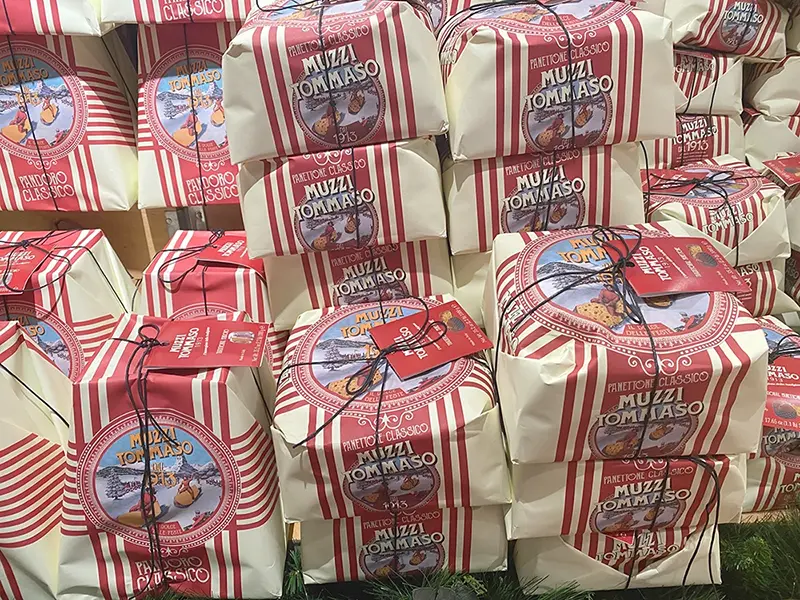
Muzzi Tommaso
In the town of Foligno, Umbria the Muzzi Tommaso family has operated a pastry shop for more than a century. There are various dates ranging from 1795, 1875, and 1913 attributed to the shop’s founding.
Muzzi Tommaso is a major producer of cross-branded bread, creating partnerships with other Italian brands to produce unique versions of panettone. The company now makes panettone in a variety of flavors including limoncello and Amarena cherries. The candied cherries are made by another Italian company, Fabbri, who invented the syrupy fruit in 1905. The panettone is a collaboration between the two.
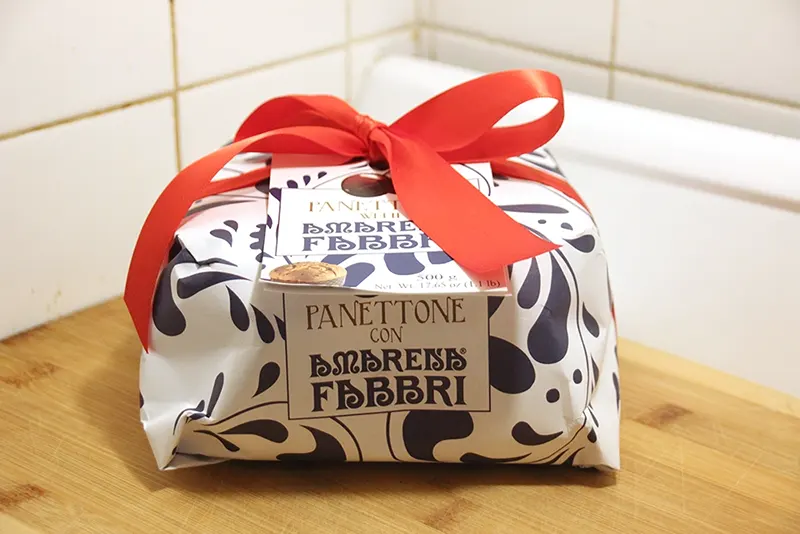
ITALIAN AMERICAN PANETTONE
Panettone was not a universal Italian American tradition. One reason may well be that the mass production of panettone didn’t begin in Milan and northern Italy until the great migration began to slow. When southern Italians first began coming to the United States in the 1880s, panettone was still very much a regional Italian food. Despite having large populations of Italian Americans, cities like Chicago and Boston, bakeries simply don’t make panettone, and many don’t even import the bread. There are a few bakeries on the East coast that do produce the bread, but even these are typically contracted to Italian bakeries.
Ferrara
Not to be confused with the Ferrara bakery in Chicago, the Ferrara pastry shop in New York manufactures and imports their own branded panettone.
Cafe Ferrara has been serving Little Italy, Manhattan since 1892. In addition to fresh pastries, the company also produces a line of boxed products like cannoli, torrone, and panettone. The company is a staple of Little Italy.
Di Bruno Bros.
In Philadelphia, the speciality food stores run by the Di Bruno brothers started off by selling cheese. Back in 1939, Danny and Joe Di Bruno opened a cheese shop on 9th Street in south Philadelphia. The street is an open air market known as the Italian Market.
In addition to importing panettone from companies like Galup and Loison, Di Bruno sells their own house brand. Their version is baked in Abruzzo and filled with raisins soaked in orange liqueur. The bread is intentionally dense, and they suggest serving it with cheese.
Settepani
This Brooklyn-based bakery was founded in 1992 by Nino Settepani. Born in Italy, he immigrated to New York as a child and settled in Williamsburg, an Italian neighborhood where the shop is located. The bakery also has a Harlem location operating since 2000.
Settipani bakes their panettone right in Brooklyn – and regularly restock through the season.
REINVENTING LUXURY PANETTONE
Panettone evolved during the course of the 20th century from an occasional luxury into a mass market commodity. So the natural inclination in the 21st century was to reinvent it once again as a new luxury product. In some cases, that simply meant branding partnerships, like Dolce & Gabbana partnering with Fiasconaro. These breads are sold at upscale retailers like Neiman Marcus and Bergdorf Goodman.
But the more interesting variations on this are the artisan bakers who are pushing innovations in panettone. One of the earlier bakers to explore panettone was Jim Lahey, founder of the Sullivan Street Bakery. The boutique New York bakery first started selling panettone in 1996 and was one of the first to sell artisanal, high quality panettone in New York City.
Roy
Perhaps the most noteworthy of the nouveau panettones comes from Roy Schvartzapel. Schvartzapel spent years learning panettone technique from the pastry chef Iginio Massari as well as cooking in restaurants of other iconic master chefs. His first bakery Common Ground opened Houston in 2014, but since then he’s been working on a project known as From Roy.
From Roy is an online purveyor of only one thing: panettone. The luxurious panettones come in a variety of flavors like chocolate, pistachio, and a classic pairing of orange and raisin. The breads are filled with oversized air pockets, a signature of Roy’s product. And the $95 breads usually sell out weeks before Christmas.
Giuseppe Giusti
Giuseppe Giusti lays claim to being the oldest vinegar producer in Italy. Located in Emilia Romagna, the company first started manufacturing vinegar in 1605 and today is known for high quality Balsamic Vinegar of Modena. Their products are aged as long as twenty five years. Their speciality in balsamic vinegar may not seem to be a natural fit to produce a panettone.
However, the company, now led by the 17th-generation of the founding family, has diversified in recent years and panettone is the latest experiment. Giusti makes a variety of condiments, sauces, and even a vermouth, and seeks collaborations with other artisans like chocolate makers.
The journey toward panettone began in 2007, according to Irene S. Levine at Forbes, when CEO Stefani Giusti met with Andrea Muzzi at a trade show. Muzzi runs Tommaso Muzzi, a manufacturer of high quality Italian breads including Panettone, pandoro and Colomba. As the two regularly encountered each other around the world, Giusti was encouraged to find ways of incorporating the signature vinegar into a baked product.
For the panettone, Balsamic vinegar is incorporated into the enriched dough. Raisins are macerated in balsamic as well before they are added. The Colomba easter bread is topped with chocolate.
By 2021, the Colomba was introduced to Italian shoppers, and in the spring of 2023, became available in the United States. The panettone that can be shipped to the United States through the company’s online store.
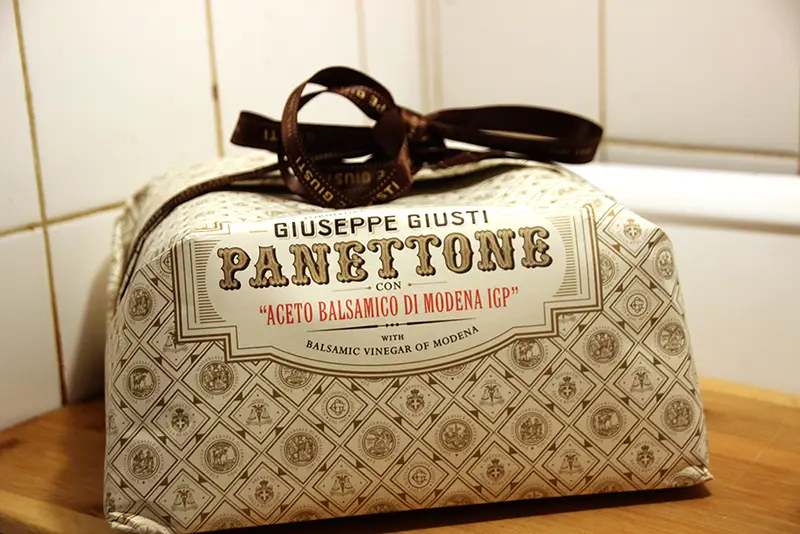
WHERE TO FIND IT
Panettone has grown in popularity in the United States. It’s no longer a niche food, but that doesn’t mean it will be easy to buy. Last year I found myself needing a last minute panettone and found empty shelves in many of the places I expected to get it. Settipani bakery did ultimately restock.
Online stores like Goldbelly and Amazon both have big selections. However, keep in mind, online orders can get lost, like my D’Onofrio panettone order earlier this week from Amazon.
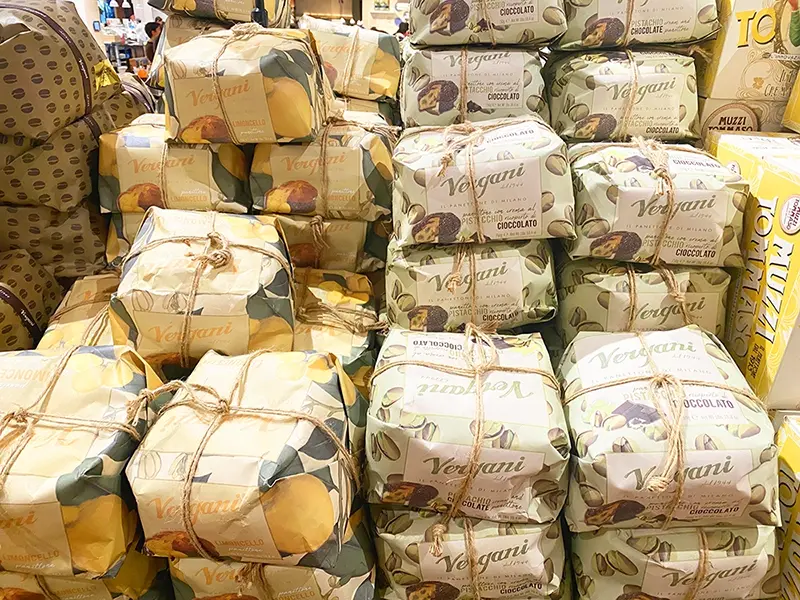
Where I did find plenty of panettone was Eataly, the combination supermarket and food hall. New York’s Flatiron District location had a huge selection at a variety of price points. I found the Fabbri Cherry flavor panettone produced by Muzzi Tommaso and Giuseppe Giusti’s balsamic vinegar bread as well. Specialty shops like Archestrtus also has a wide selection.
Just don’t wait until the last minute. The panettone will sell out.
The Ultimate Guide to Panettone
